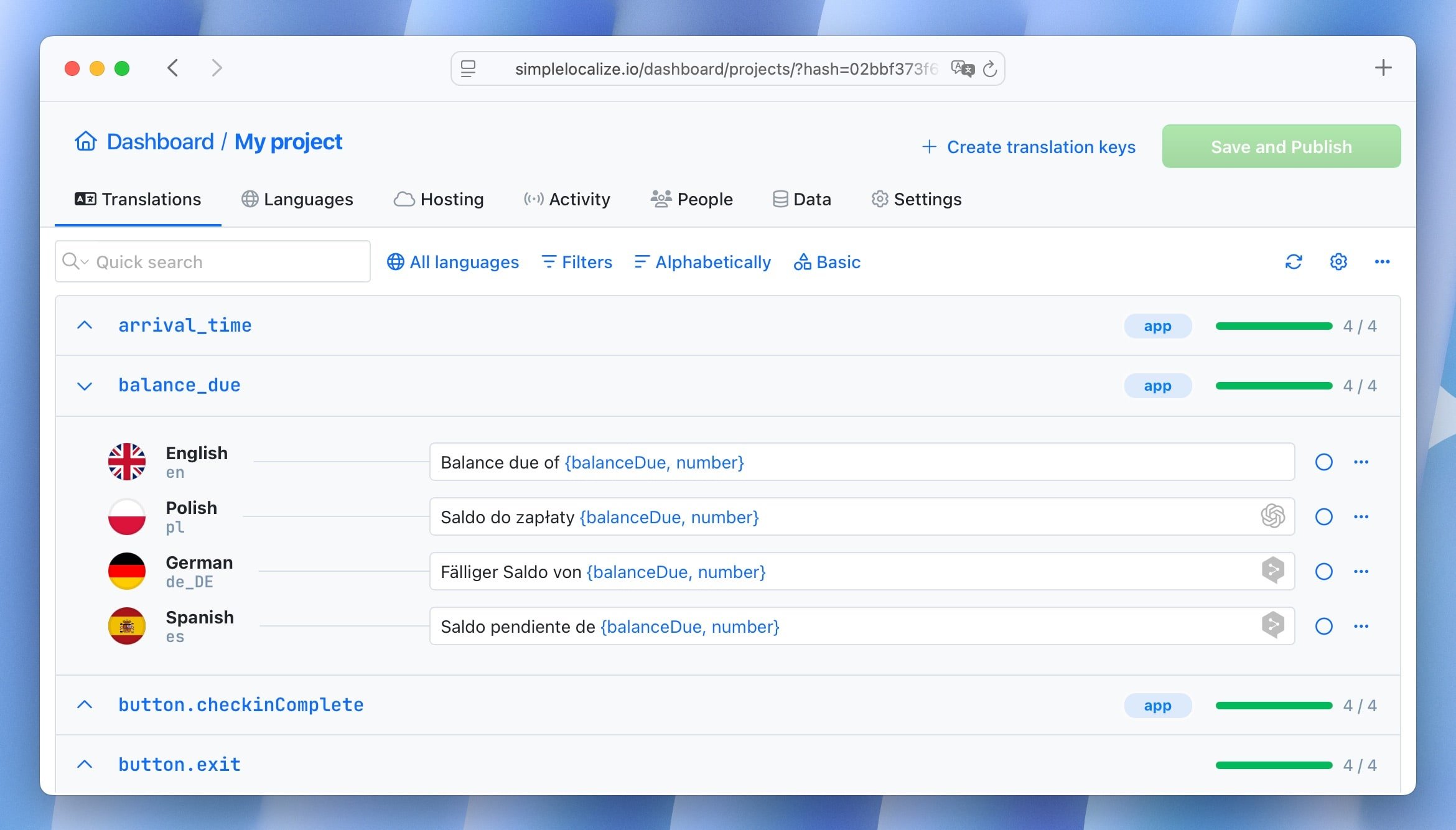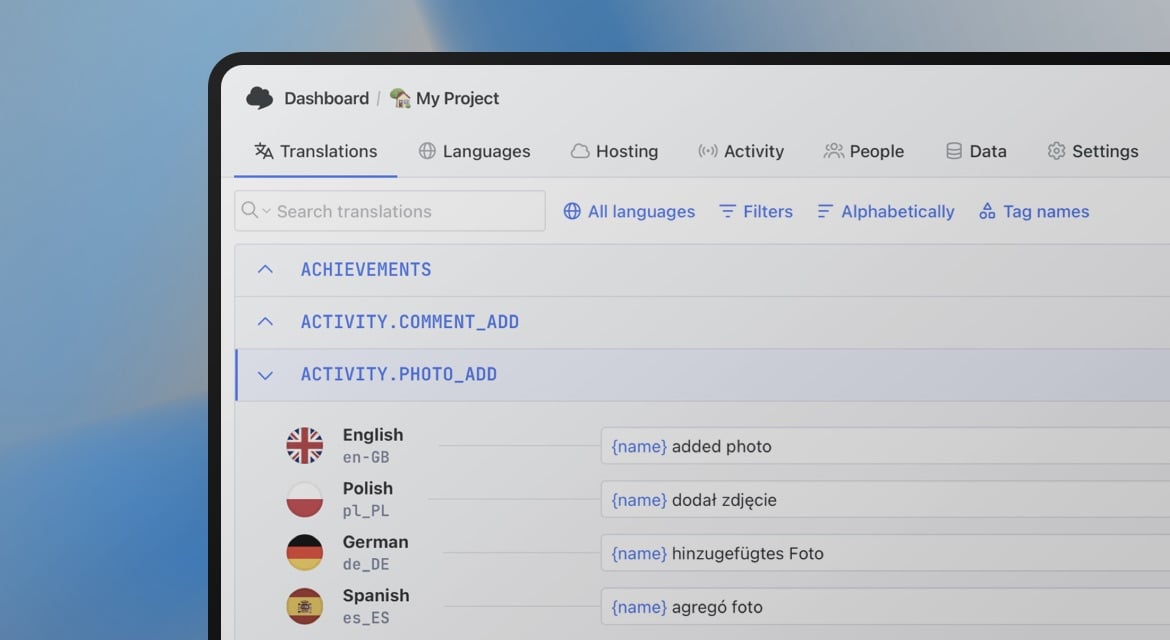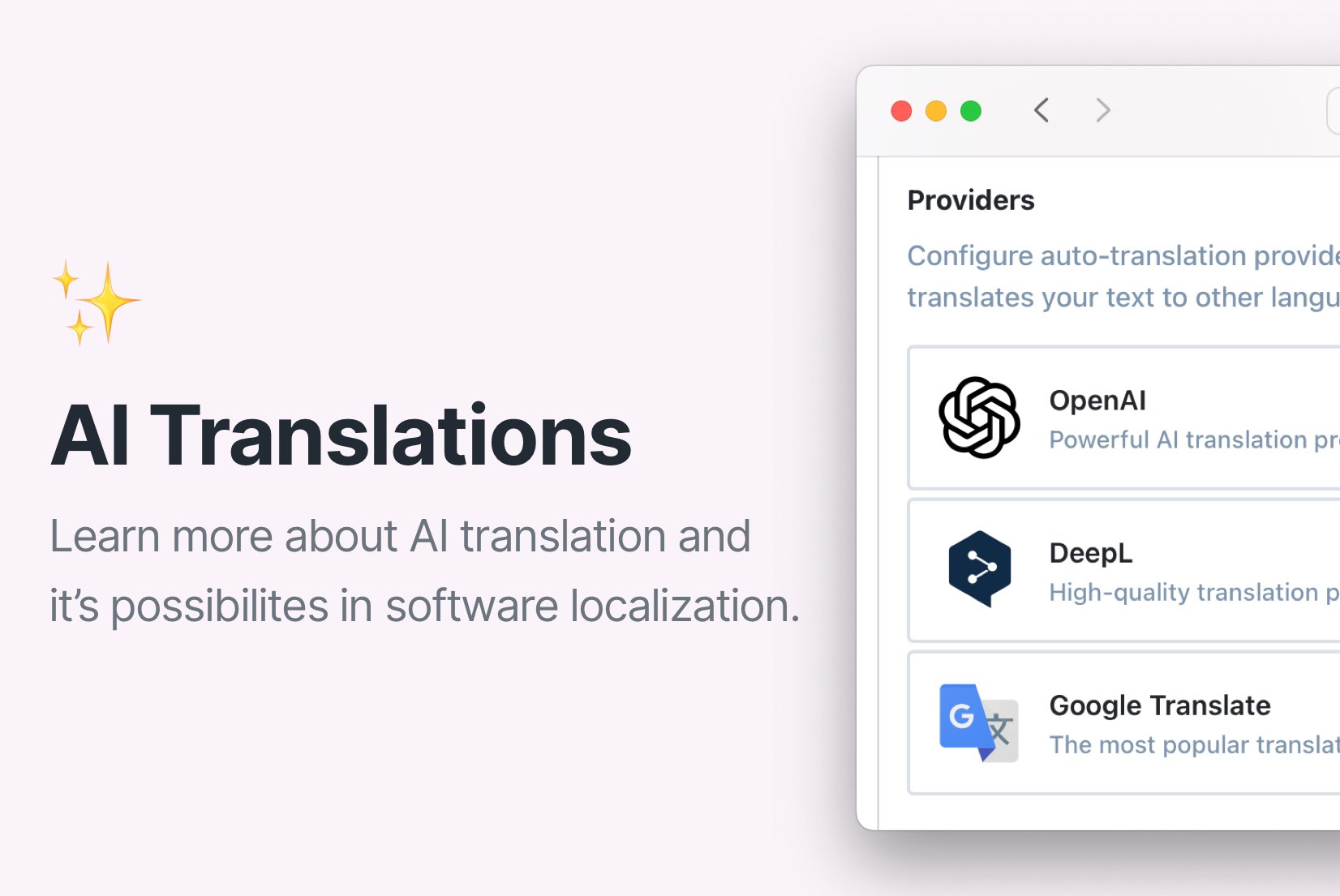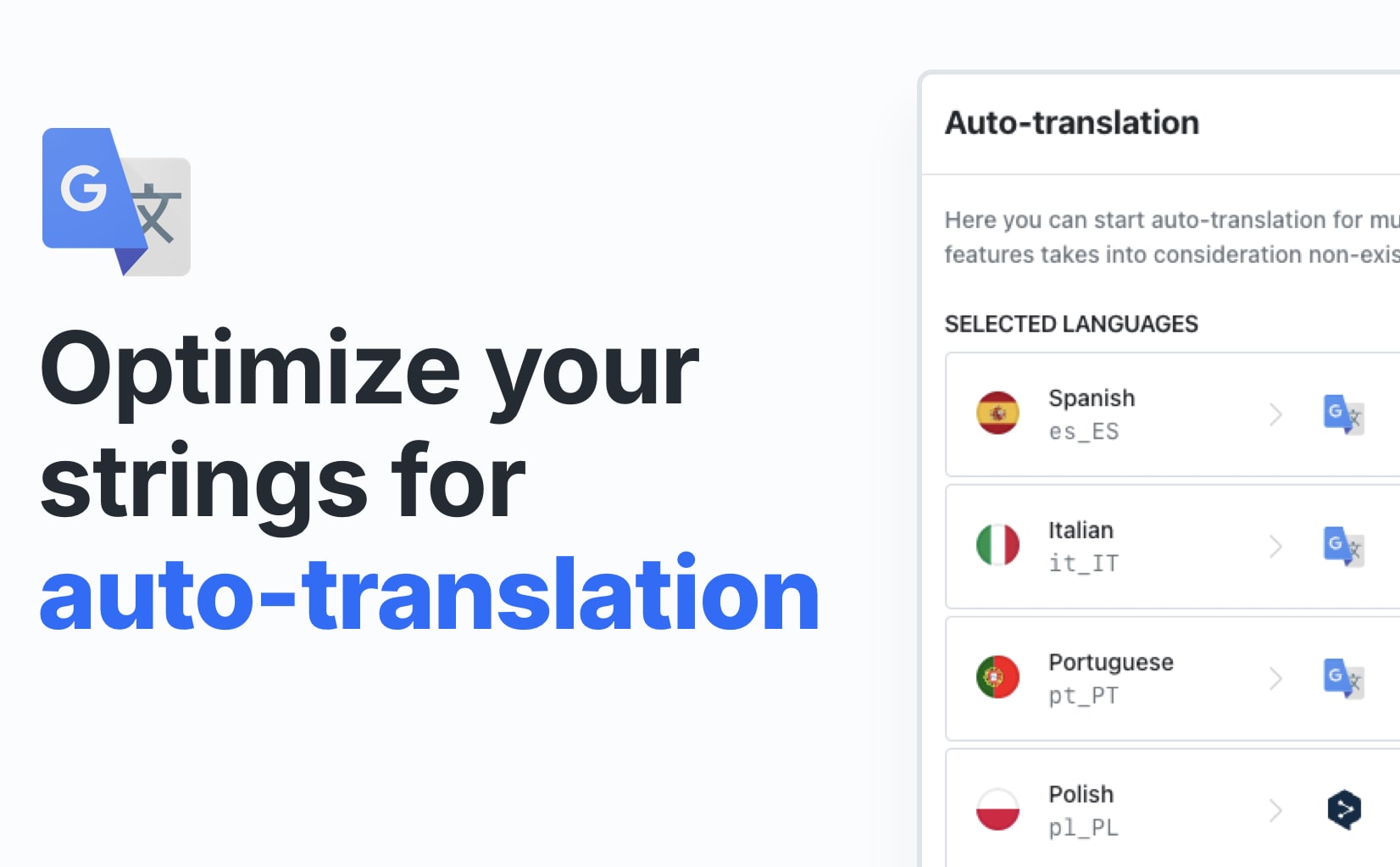List of AI and machine translation providers
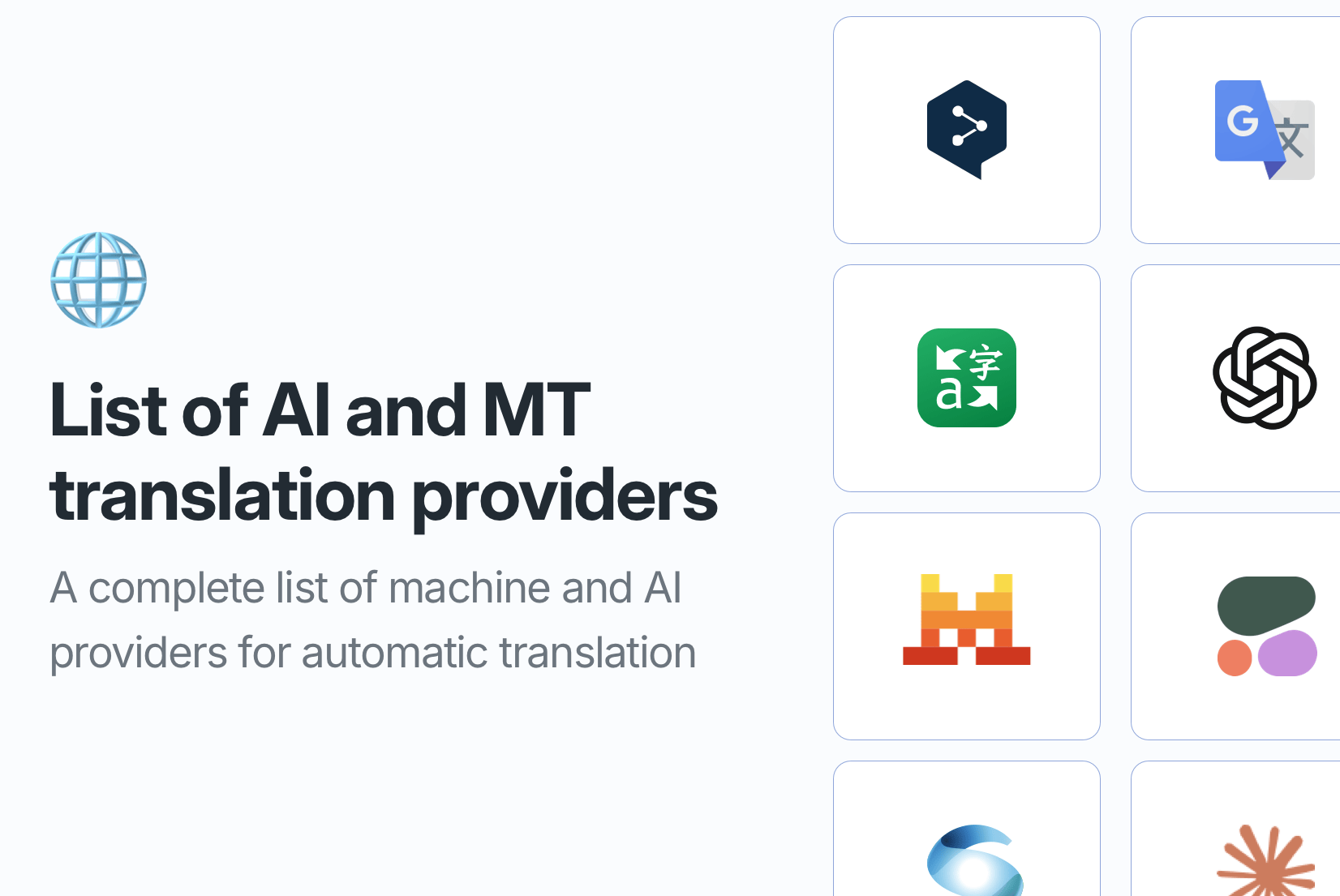
Auto-translation is a crucial component of modern localization workflows. From SaaS platforms and mobile apps to e-commerce and internal tools, automated translation helps teams reduce localization time and costs while supporting global users efficiently.
In this guide, you will find a comprehensive overview of top translation providers, both neural machine translation (NMT) engines and AI/LLM-based systems, with details about language support, pricing, API access, developer tools, and SimpleLocalize compatibility.
Overview of translation providers
This table summarizes the key features of the top machine and AI translation providers as of 2025. It includes their type, language support, API availability, and best use cases.
| Provider | Type | Languages | API | Best for |
|---|---|---|---|---|
| DeepL | NMT | 36 | Yes | High-quality, context-aware translations |
| Google Translate | NMT | 249 | Yes | Speed, affordability, wide language support |
| Microsoft Translator | NMT | 179 | Yes | Enterprise integration, Microsoft ecosystem |
| Amazon Translate | NMT | 75 | Yes | Scalable, cost-effective within AWS |
| SYSTRAN | NMT + AI | 55+ | Yes | Secure, regulated environments |
| IBM Watson Language Translator | NMT + AI | 50+ | Yes | Customizable, secure translation pipelines |
| OpenAI (ChatGPT) | LLM | All | Yes | AI-powered, conversational and creative translation |
| Anthropic (Claude) | LLM | All | Yes | Context-rich LLM translation |
| Mistral | LLM | All | Yes | Open-source, customizable LLM translation |
| Cohere | LLM | All | Yes | Flexible, API-driven LLM translation |
Translation providers
These services use neural machine translation (NMT) engines to provide fast, scalable translation capabilities. They are typically used for high-volume content where speed and cost are priorities.
DeepL
DeepL is known for its high-quality translations, especially in European languages. It uses advanced neural networks and has a strong focus on context and nuance. It focuses on accuracy and tone, making it popular among professionals.

- Type: NMT
- Languages: 36
- AI Features: Text generation, context understanding, Clarify
- API: DeepL API
- Web app: DeepL Translator
- Mobile apps: iOS and Android
- Pricing: Free tier; paid from €8.99/month
- Best for: High-quality, natural-sounding translations
- Strengths: Exceptional fluency in European languages; supports glossaries and context
- Weaknesses: Limited language support compared to Google Translate; may not handle technical jargon as well as some competitors
- SimpleLocalize Support: Yes
Google Translate / Google Cloud Translation
Google Translate is the most widely used MT system globally, translating over 100 billion words per day. With Google Cloud Translation AP they are are powerful tools for high-volume and high-speed translation across nearly every language.

- Type: NMT
- Languages: 249
- AI Features: Context-aware translation, AutoML, Glossaries
- API: Cloud Translation API
- Web app: Google Translate
- Mobile apps: iOS and Android
- Pricing: Free tier; paid from $10 per million characters
- Best for: Speed, affordability, wide language support
- Strengths: Extensive language support, fast processing, integrates with other Google services
- Weaknesses: May lack the nuance and context of DeepL; can produce less natural-sounding translations in some languages
- SimpleLocalize Support: Yes
Microsoft Translator
Microsoft Translator is part of the Azure Cognitive Services suite, optimized for enterprise environments and integrates well with Microsoft products and Azure services.

- Type: NMT
- Languages: 179
- AI Features: Customizable models, custom glossaries, security
- API: Translator Text API
- Web app: Bing Microsoft Translator
- Mobile apps: iOS and Android
- Pricing: Free tier; paid from $10 per million characters
- Best for: Enterprise integration, Microsoft ecosystem
- Strengths: Customizable models, enterprise security, Azure integration
- Weaknesses: May not match DeepL's quality in some languages; less focus on European languages
Amazon Translate
Amazon Translate is designed for developers working within AWS. It supports bulk processing and is cost-effective for high-volume needs.

- Type: NMT
- Languages: 75
- AI Features: Custom terminology, batch translation
- API: Amazon Translate API
- Web app: None (API-based service)
- Pricing: Free tier; paid from $15 per million characters
- Best for: Scalable backend translations
- Strengths: Scalable, cost-effective, solid baseline quality
- Weaknesses: Limited language support compared to Google; may not handle nuanced translations as well as DeepL
SYSTRAN
SYSTRAN offers both NMT and AI-based translation solutions, focusing on on industry-specific and privacy-sensitive environments like government, legal, and healthcare.

- Type: NMT + AI
- Languages: 55+
- AI Features: Custom domains, on-premise deployment
- API: SYSTRAN Translate API
- Web app: SYSTRAN Translate
- Pricing: Free tier; paid from $15 per month (PRO API)
- Best for: Secure, regulated environments
- Strengths: Strong in regulated industries, customizable for specific domains, good security features
- Weaknesses: Smaller language set than Google or Microsoft; may not be as fluent as DeepL in European languages
IBM Watson Language Translator
IBM Watson supports multiple domains like patents, finance, and medicine. It's suitable for industries requiring customizable and secure translation pipelines, especially where privacy and on-premise hosting are key.

- Type: NMT + AI
- Languages: 50+
- AI Features: CDomain adaptation, on-premise options
- API: Watson Language Translator API
- Best for: Industry-grade, customizable solutions
- Strengths: Strong in domain-specific translations, customizable models, good security features
- Weaknesses: Limited language support compared to Google; may not be as fluent as DeepL in European languages
AI and LLM-based translation providers
These providers leverage large language models (LLMs) to offer advanced translation capabilities, often with a focus on context, creativity, and conversational AI. They are ideal for applications requiring more than just literal translations.
OpenAI (ChatGPT)
OpenAI provides powerful LLMs like ChatGPT that can handle translation tasks with a focus on context and natural language understanding. They are particularly useful for creative and conversational translations. It's ideal for short strings, variable context, and user-generated content.

- Type: LLM
- Languages: All major languages
- AI Features: Tone matching, variable handling, contextual awareness
- API: OpenAI API
- Web app: ChatGPT
- Mobile apps: iOS and Android
- Pricing: Free tier; Pay-as-you-go (API); ChatGPT Plus for $20/month
- Best for: Creative and dynamic translation
- Strengths: Contextual understanding, conversational tone, flexible handling of variables
- Weaknesses: May not be as accurate for technical translations; requires careful prompt engineering for best results
- SimpleLocalize Support: Yes
Anthropic (Claude)
Anthropic offers Claude, a powerful LLM that excels in understanding context and generating human-like translations. It handles large-context translations well, with a focus on safety and reliability.

- Type: LLM
- Languages: All major languages
- AI Features: Contextual understanding, safety features
- API: Anthropic API
- Web app: Claude
- Mobile apps: None (API-based service)
- Pricing: Pay-as-you-go (API)
- Best for: Context-rich translations
- Strengths: Strong contextual understanding, safety features, good for complex translations
- Weaknesses: May not be as widely adopted as OpenAI; requires careful prompt engineering for best results
Mistral
Mistral is an open-source LLM that provides flexible translation capabilities. It allows developers to customize models for specific translation tasks, making it suitable for specialized applications.

- Type: LLM (Open-source)
- Languages: Multilingual (depending on model)
- AI Features: Fine-tuning, open weights, customizable
- API: Mistral API
- Web demos: Available via third-party providers (e.g., Hugging Face Spaces)
- Pricing: Open-source; pay for hosting/API usage
- Best for: Customizable, open-source translation
- Strengths: Open-source flexibility, customizable models, good for specialized applications
- Weaknesses: Requires technical expertise to set up and maintain; may not have the same level of support as commercial providers
Cohere
Cohere provides LLMs that can be used for translation tasks, focusing on flexibility and API-driven access. It allows developers to integrate translation capabilities into their applications easily.

- Type: LLM
- Languages: Multilingual (depending on model)
- AI Features: Text generation, embeddings, RAG
- API: Cohere API
- Web app: None (API-based, CLI tools available)
- Pricing: Pay-as-you-go (API)
- Best for: Flexible, API-driven translation
- Strengths: Easy API integration, flexible usage, good for dynamic applications
- Weaknesses: May not have the same level of language support as larger providers
Smaller and specialized providers
In addition to the major players, there are several smaller and specialized translation providers that focus on niche markets or specific languages. These can be valuable for certain use cases, such as legal, medical, or technical translations.
- ModernMT: An open-source NMT engine that allows for customizable translation models, suitable for specialized domains.
- LingvaNex: Offers translation APIs and SDKs for various platforms, focusing on privacy and security.
- Tilde: A translation platform that combines NMT with human post-editing. Provides secure, custom MT for public institutions. Specializes in Baltic and Nordic languages.
- Intento: An aggregator of multiple MT engines via unified API, allowing users to choose the best engine for their needs.
- Prompt: Long-established MT provider with desktop and server solutions, strong in Russian, German, and European language pairs.
- Apertium: An open-source rule-based MT system, particularly strong in Spanish and Catalan languages. It is community-driven and supports many language pairs. Used in academic and public research projects.
- KantanMT: A customizable MT built for enterprises, allowing users to create their own translation models. It supports a wide range of languages and domains.
- eTranslation (EU): The European Commission's translation service, providing high-quality translations for EU institutions and citizens. It supports all official EU languages and is focused on public sector needs.
- Elia AI: A translation platform that combines AI and human expertise to provide high-quality translations, specialized in document translation with structure preservation. Suitable for PDFs, manuals, and technical content.
- TranslateFX: A translation service that focuses on financial and legal documents, providing specialized translations with a strong emphasis on accuracy and compliance.
- Reverso: A translation and language learning platform that offers contextual translations, synonyms, and examples. It is particularly useful for language learners and casual users.
- Papago: A translation service by Naver, popular in South Korea. It supports multiple languages and is known for its accuracy in Asian language pairs.
How to choose the best translation provider
When selecting a translation provider, consider the following factors:
- Language support: Ensure the provider supports the languages you need, especially if you have specific regional requirements.
- Quality: Evaluate the translation quality for your specific content type. Some providers excel in certain languages or domains.
- API access: Check if the provider offers a robust API for integration into your applications. This is crucial for automating translation workflows.
- Pricing: Compare pricing models, including free tiers, pay-as-you-go options, and subscription plans. Consider your expected volume of translations and budget.
- Developer tools: Look for SDKs, libraries, and documentation that make it easy to integrate the translation service into your applications.
- Customization: If you have specific terminology or style requirements, check if the provider offers customization options like glossaries or domain adaptation.
- Security and compliance: For sensitive content, ensure the provider meets your security and compliance requirements, especially if you operate in regulated industries.
Check out our comparison of DeepL, Google Translate, and OpenAI for more details on how these providers stack up against each other in terms of features, pricing, and performance.
Auto-translate your software with SimpleLocalize
For software localization, auto-translation is a powerful tool that can significantly speed up the process. Thanks to the integration with translation providers, you can automatically translate your software strings and content directly within your localization platform.
For example, SimpleLocalize supports the most popular translation providers, allowing you to:
- Automatically translate your software strings using DeepL, Google Translate, OpenAI, and others.
- Use glossaries and context features to improve translation quality.
- Customize translations with your own terminology and style preferences.
- Use your own API keys to connect to translation providers.
Learn more about auto-translation features in SimpleLocalize documentation and check out our tips for effective auto-translation to get the best results.
Register for a free account on SimpleLocalize and start automating your software translations today!
